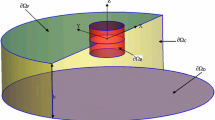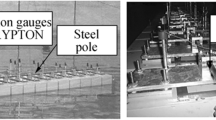Abstract
The effect of coupling between sloshing and ship motions in the evaluation of slosh-induced interior pressures is studied. The coupling between sloshing loads and ship motions is modelled through a hybrid algorithm which combines a potential flow solution based on transient Green function for the external ship hydrodynamics with a viscous flow solution based on a multiphase interface capturing volume of fluid (VOF) technique for the interior sloshing motion. The coupled algorithm accounts for full nonlinear slosh forces while the external forces on the hull are determined through a blended scheme of linear radiation-diffraction with nonlinear Froude-Krylov and restoring forces. Consideration of this level of nonlinearities in ship motions is found to have non-negligible effects on the slosh-coupled responses and slosh-induced loads. A scheme is devised to evaluate the statistical measure of the pressures through long-duration simulation studies in extreme irregular waves. It is found that coupling significantly influences the tank interior pressures, and the differences in the pressures between coupled and uncoupled cases can be as much as 100% or more. To determine the RAO over the frequency range needed for the simulation studies in irregular waves, two alternative schemes are proposed, both of which require far less computational time compared to the conventional method of finding RAO at each frequency, and the merits of these are discussed.




















Similar content being viewed by others
References
Bhattacharyya R (1978) Dynamics of marine vehicles. Ocean engineering. Wiley
Bulian G, Cercos-Pita J (2018) Co-simulation of ship motions and sloshing in tanks. Ocean Eng 152:353–376
Cercos-Pita JL, Bulian G, Perez-Rojas L, Francescutto A (2016) Coupled simulation of nonlinear ship motions and a free surface tank. Ocean Eng 120:281–288
Clauss GF (1999) Task-related wave groups for seakeeping tests or simulation of design storm waves. Appl Ocean Res 21(5):219–234
Faltinsen O, Timokha A (2009) Sloshing. Cambridge University Press
Gou Y, Kim Y, Kim TY (2011) A numerical study on coupling between ship motions and sloshing in frequency and time domains. Proceedings of the 21st International Ocean and Polar Engineering Conference, 158–164
Hashimoto H, Ito Y, Kawakami N, Sueyoshi M (2012) Numerical simulation method for coupling of tank fluid and ship roll motions. Proceedings of the 11th International Conference on the Stability of Ships and Ocean Vehicles, 477–485
Hert CW, Nichols BD (1981) Volume of fluid (VOF) method for the dynamics of free boundaries. J Comput Phys 39(1):201–225
Hirdaris SE, Bai W, Dessi D, Ergin A, Gu X, Hermundstad OA, Huijsmans R, Iijima K, Nielsen UD, Parunov J, Fonseca N, Papanikolaou A, Argyriadis K, Incecik A (2014) Loads for use in the design of ships and offshore structures. Ocean Eng 78:131–174
IACS (2001) Standard Wave Data, Recommendation No. 34. International Association of Classification Societies Ltd., London
Jasak H (1996) Error analysis and estimation for the finite volume method with applications to fluid flows. PhD thesis
Jasak H, Tukovic Z (2006) Automatic mesh motion for the unstructured finite volume method. Transactions of FAMENA, 30(2):1–20
Jiang SC, Teng B, Bai W, Gou Y (2015) Numerical simulation of coupling effect between ship motion and liquid sloshing under wave action. Ocean Eng 108:04–154
Kim Y (2002) A numerical study on sloshing flows coupled with ship motion—the anti-rolling tank problem. J Ship Res 46(1):52–62
Kim Y, Shin YS, Lin W, Yue DKP (2003) Study on sloshing problem coupled with ship motion in waves. Proceedings of the 8th International Conference on Numerical Ship Hydrodynamics
Lin WM, Yue DKP (1990) Numerical solutions for large-amplitude ship motions in time domain. Proceedings of the 17th Symposium on Naval Hydrodynamics
Mikelis NE, Journee JMJ (1984) Experimental and numerical simulations of sloshing behaviour in liquid cargo tanks and its effect on ship motions. Proceedings of the National Conference on Numerical Methods for Transient and Coupled Problems, 9–13
Nam BW, Kim Y, Kim DW, Kim YS (2009) Experimental and numerical studies on ship motion responses coupled with sloshing in waves. J Ship Res 53(2):68–82
Rusche H (2002) Computational fluid dynamics of dispersed two-phase flows at high phase fractions. PhD thesis
Saripilli JR, Sen D (2017a) Numerical studies of coupling effect of sloshing on 3D ship motions. Int J Offshore Polar Eng 27(1):27–35
Saripilli JR, Sen D (2017b) Numerical studies on sloshing loads using sloshing coupled ship motion algorithm. Proceedings of the 27th International Ocean and Polar Engineering Conference, 1093–1102.
Saripilli JR, Sen D (2018) Numerical studies on effects of slosh coupling on ship motions and derived slosh loads. Appl Ocean Res 76:71–87
Sen D (2000) Efficient computation of influence coefficients in rankine-panel based methods of computational ship hydrodynamics. Ocean Eng Int 5:16–30
Sen D (2002) Time domain computation of large amplitude 3D ship motion with forward speed. Ocean Eng 29:973–1002
Sen D, Saripilli JR (2017) Numerical studies on slosh-induced loads using coupled algorithm for sloshing and 3D ship motions. Proceedings of the 36th International Conference on Ocean, Offshore and Arctic Engineering, 1–9
Servan-Camas B, Cercos-Pita JL, Colom-Cobb J, Garcia-Espinosa J, Souto-Iglesias A (2016) Time domain simulation of coupled sloshing seakeeping problems by SPH-FEM coupling. Ocean Eng 123:383–396
Singh SP, Sen D (2007) A comparative linear and nonlinear ship motion study using 3-d time domain methods. Ocean Eng 34:1863–1881
Weller HG, Tabor G, Jasak H, Fureby C (1998) A tensorial approach to computational continuum mechanics using object-oriented techniques. Comput Phys 12(6):620–631
Zhao D, Hu Z, Chen G, Chen X, Feng X (2018) Coupling analysis between vessel motion and internal nonlinear sloshing for FLNG applications. J Fluids Struct 76:431–453
Author information
Authors and Affiliations
Corresponding author
Rights and permissions
About this article
Cite this article
Saripilli, J.R., Sen, D. Sloshing-Coupled Ship Motion Algorithm for Estimation of Slosh-Induced Pressures. J. Marine. Sci. Appl. 17, 312–329 (2018). https://doi.org/10.1007/s11804-018-0031-7
Received:
Accepted:
Published:
Issue Date:
DOI: https://doi.org/10.1007/s11804-018-0031-7




